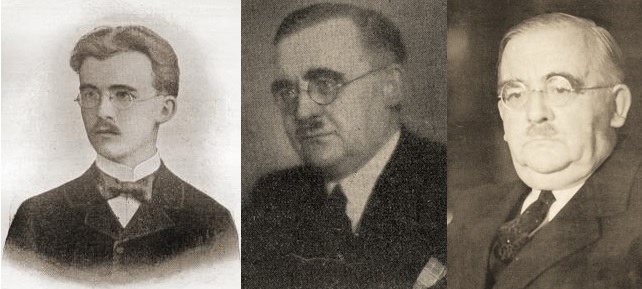
Edward Winter

***
A miscellany of Chess Notes items on Milan Vidmar (1885-1962).
From Paul Timson (Whalley, England):
‘On perusing Jan Timman’s book The Art of Chess Analysis I came across the following incredible passage:
“The Vidmar Memorial Tournament is held every two years. For some reason or other, the fifth in the series, in 1979, attracted me immediately. Not that I have ever played through a game of Vidmar’s – at least, never a game he won; but probably I have seen a number of his losses printed among the collected games of Alekhine, Capablanca, and Euwe. Frankly, this splendid tournament is rather an exaggerated mark of honor for a not very brilliant chess player.”
Whilst Timman is entitled to his own opinion of Vidmar’s play, it seems curious that he should commit it to print without bothering to play through any of Vidmar’s wins.’
(953)
As mentioned on page 170 of Kings, Commoners and Knaves, the passage in question by Jan Timman is on page 194 of the RHM edition of 1980 and on page 185 of the Cadogan version of 1997.
From Hugh Myers (Davenport, IA, USA):
‘Timman’s opinion was unfair, but Vidmar was not known for brilliance or originality. If scoring percentage is the main thing, he deserves more recognition. Otherwise – lack of it is no great tragedy. Tartakower was a chess genius. Vidmar was a talented journeyman.’
(998)
An extract from Aleksander Kostyev’s From Beginner to Expert in 40 Lessons (page 79):
‘During the London International Tournament of 1922, Grandmaster M. Vidmar adjourned his game against Capablanca in a lost position. The time came to resume the game. Convinced that there was no point in continuing the game, Vidmar awaited his opponent with the intention of resigning. Time passed, but Capablanca didn’t appear – some unforeseen circumstance had detained him. Looking at his clock Vidmar suddenly realized that his opponent’s flag was about to fall. Capablanca was on the point of losing and he, Vidmar, would gain a formal victory. Not hesitating for an instant, the Yugoslav grandmaster rushed up to the board and just had time to resign the game by knocking his king over a moment before the controller would have declared him the winner on time. The British press dubbed Vidmar’s action “the most beautiful move ever played in a chess game”.’
Before the sentimentalists perpetuate the story, it would be interesting to know its source. Certainly it is not mentioned in the Times’ daily report (17 August 1922). Another unfortunate fact: the game was never adjourned.
(986)
Bernard Cafferty (Hastings, England) writes:
‘The story about Capa not turning up, because he thought Vidmar had indicated he was resigning (an error probably due to a misunderstanding in the use of French, according to Vidmar) is told in some detail on pages 134-6 of Vidmar’s Goldene Schachzeiten.’
(1025)
A further example of how fanciful anecdotes appear in different guises. The 8/1968 issue of the Cuban magazine Jaque Mate, page 22, has an entirely transformed version, placed 14 years later than London, 1922:
‘The most elegant move. Nottingham Tournament, Round X, 21 August. Vidmar-Capablanca. After playing his 36th move, Vidmar felt ill and asked for permission to postpone the game. Capablanca agreed. The Cuban, who had a won game, showed Vidmar the move he was going to seal, asking him whether he would play on after seeing it. Vidmar replied in the affirmative, and the Director of the Tournament fixed the day when the game would continue. On the selected date Capablanca did not turn up for play, owing to previously made social engagements. When only a few seconds were left before the regulation time-limit had passed, Vidmar, seeing that Capablanca was not there, turned over his king and resigned. Without doubt an elegant move!’
In C.N. 986 we pointed out that Capablanca-Vidmar, London 1922 was never adjourned. The same applies to Vidmar-Capablanca, Nottingham 1936, which lasted only 30 moves (the time-limit was 36 moves in two hours). The start of the latter game was postponed on account of Vidmar’s indisposition.
(1208)
Bernard Cafferty has sent us a copy of pages 308-309 of Vidmar’s 1951 book, published in Ljubljana, Pol stoletja ob šahovnici, which states that play (at 20 moves per hour) was from 14.00 to 18.00, after which there was an adjournment until 20.00. Mr Cafferty comments:
‘This appears to reinforce Vidmar’s claim that his 1922 London tournament game with Capablanca was adjourned and the latter’s clock set in motion in the evening adjournment session. This is at variance with C.N. 986, reiterated in C.N. 1208. The question is, I suppose, whether Vidmar’s memory was at fault, or whether the correspondent of The Times missed the incident, possibly because it was too late for his deadline, or he did not attend the evening session for adjournments, or he relied on Capablanca’s impression that Vidmar had resigned after sealing his move.’
We can add that The Times of 17 August 1922 (page 9) contains Capablanca’s report on this game and the rest of the day’s play. It also gives a chart of these 13th-round results. Only one game is listed as having been adjourned: Znosko-Borovsky v Atkins (which lasted 85 moves in all). The Times was, however, able to include the result of Wahltuch v Euwe, which went to 54, and this makes it clear that the newspaper used the word ‘adjourned’ only when play was suspended a second time (i.e. at the end of the session that began at 20.00). Consequently, it cannot after all be ruled out that the Capablanca v Vidmar game was broken off between 18.00 and 20.00.
One final discrepancy: Capablanca writes that ‘finally on the 42nd move Dr Vidmar resigned’, but on the same page, The Times’s score of the game states that Black resigned after playing 42...Kf7. Other sources (including Capablanca’s A Primer of Chess, page 229) give no 42nd move by Black, but just 42 Rb8+ Resigns.
(1474)
Black in the game below was Dr Milan Vidmar’s son, then aged nearly 21.
Alexander Alekhine – Milan Vidmar Junior
Ljubljana, 11 December 1930
Queen’s Gambit Declined
1 d4 Nf6 2 Nf3 d5 3 c4 e6 4 Nc3 Nbd7 5 Bg5 Be7 6 a3 O-O 7 e3 c6 8 Bd3 dxc4 9 Bxc4 b5 10 Ba2 a6 11 e4 c5 12 e5 Ne8 13 Bxe7 Qxe7 14 d5 exd5 15 Nxd5 Qd8 16 O-O Nc7 17 Nxc7 Qxc7 18 e6 fxe6 19 Bxe6+ Kh8 20 Ng5 Nf6 21 Qf3 Bb7 22 Qh3 h6 23 f4 Ne4 24 Bf5 Rxf5 25 Qxf5 hxg5 26 fxg5 c4 27 Kh1Qc5 28 Qh3+ Kg8 29 g6 Ng5 30 Qg4 Ne4 and Black resigned.
Source: Magyar Sakkvilág, February 1931, page 70.
(2099)
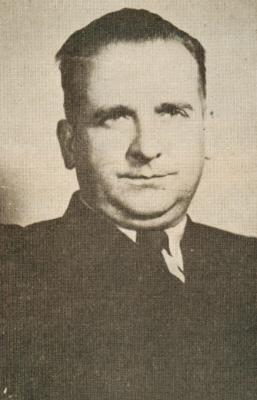
Milan Vidmar Jr (1909-80), in a photograph published on page 42 of the February 1950 Chess Review.
(6960)
In the light of the recent discussion of Carlsbad, 1911 (e.g. on pages 8-9 of the 6/1999 New in Chess), it is worth recalling the opinion of Wolfgang Heidenfeld, given on page 33 of the January 1971 BCM (in a review of the BCM’s reprint of the tournament book):
‘The reviewer of Carlsbad 1911 is handicapped by the author: in his autobiographical work Goldene Schachzeiten Dr Vidmar calls it “the worst book I have ever written simply because it carried the shabbiest fee I have ever received”. Let me, however, say at the outset that, though not one of the great tournament books (in the class of St Petersburg 1914, New York 1924, Carlsbad 1929, Zurich 1959 or Santa Monica 1966) it is a good deal better than any of the tournament books edited by Bogoljubow, Maróczy and Teichmann, easily the three most boring authors of tournament books, and quite a bit above many other books not fathered by either [sic] of these three prize bores.’
(2322)
Simon Browne (Chelsea, Australia) mentions that page 158 of the 3/1999 Quarterly for Chess History gives a table of Milan Vidmar’s chess record which states that in 1936 he defeated Reshevsky in a match +3 –2 =1. Our correspondent comments that Reshevsky was regarded at the time as a possible world championship contender but that the book Samuel Reshevsky by Stephen W. Gordon (Jefferson, 1997) does not refer to the match.
We offer a few remarks. The entry on Vidmar in the second edition of the Oxford Companion to Chess (page 441) also suggests that he won a formal match against Reshevsky in 1936, but he did not. The encounters were merely a series of six quick games, as Vidmar himself noted on page 535 of his memoirs, Pol stoletja ob šahovnici (Ljubljana, 1951): ‘Tam mi je bil pripravil presenečenje: z Reshevskym sem moral igrati 6 brzih partij. Zmagal sem s 3½:2½.’
Vidmar’s visit was reported on page 225 of the October 1936 Chess Review, which described the games against Reshevsky as ‘offhand’:
‘Soon after the Nottingham Congress Dr Milan Vidmar sailed for the United States. In the course of his short stay he quite naturally mixed a little chess with his engineering activities – a simultaneous exhibition at the Capital City Chess Club in Washington, DC; offhand games against Denker and Kashdan at the Manhattan Chess Club and Reshevsky at the Marshall Chess Club – and voiced his opinions on a variety of chess topics.
He believes that in a match between the United States and Russia the American players would be victorious; that the younger masters are not better than the older masters but that they can stand more punishment; that Fine has reached the peak but Reshevsky still has unplumbed possibilities; that Kashdan is the most talented player in America.’
(3518)
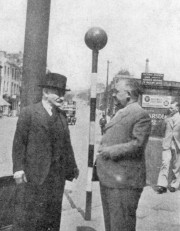
Lasker and Vidmar, Nottingham, 1936
See Photographs of Nottingham, 1936.
Readers are invited to ponder which prominent chess master wrote a book containing this (typical) page:
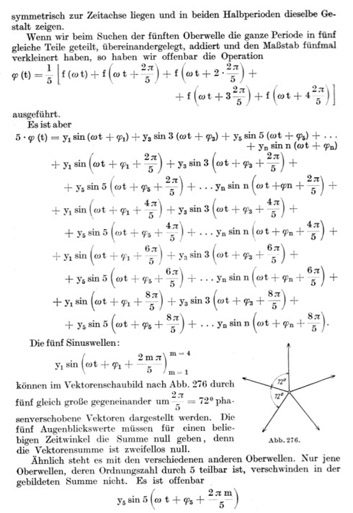
(3578)
The illustration was page 359 of Vorlesungen über die wissenschaftlichen Grundlagen der Elektrotechnik by Milan Vidmar (Berlin, 1928).
Our collection contains various non-chess works by Vidmar, but the only one in which we have found any chess references is Das Ende des Goldzeitalters (second edition, Brunswick, 1942).
(3592)
From pages 6-7 of Chess Traps, Pitfalls, and Swindles by I.A. Horowitz and F. Reinfeld (New York, 1954):
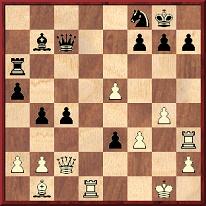
‘Teichmann was blind in one eye, but he had a keen sight of the board just the same. Having given up the exchange in return for a pawn, he is somewhat at a material disadvantage. After a careful study of the position he played 1...Rg6.
Tarrasch, at that time (1907) one of the world’s greatest masters, annotated this game for a newspaper column. Ridiculing Teichmann’s move, he pointed out that “of course 1...Qxe5 was the right move. If then 2 Qxc4 Rd6! 3 Rxd6?? e2! and Black wins on the spot!” Tarrasch added a number of sarcastic remarks and some involved variations which we need not go into here. His note was copied in columns and magazines the world over, with no dissenting voice.
Only when the book of the tournament (Carlsbad, 1907) appeared several years later did the chess world find out what Teichmann had seen with his one good eye. The fact is that [the above diagram] is the setting for a particularly devilish pitfall that Vidmar had set for his opponent. Tarrasch quite overlooked that 1...Qxe5?? is a fearful blunder.’
Horowitz and Reinfeld added that the reply would be 2 Qxh7+ Nxh7 3 Rd8+ Nf8 4 Rh8+ Kxh8 5 Rxf8 mate, but their narrative is incorrect, for the queen sacrifice was pointed out shortly after Tarrasch’s note appeared in the Deutsche Schachzeitung, which was three years before the tournament book was published.
The game was played on 7 September 1907, and Tarrasch’s annotations in the Berliner Lokalanzeiger of 15 November 1907 were given on pages 83-84 of the March 1908 Deutsche Schachzeitung.
The next issue of the magazine (i.e. April 1908, page 132) had the following:
‘Graz (F. Poljanec). Sie setzen S. 84 rechts, 26. Zug, nach Dc7xe5 (von Dr. Tarrasch empfohlen und von Schlechter approbiert) in fünf Zügen mat: 27 Dh7+: Sh7: 28 Te6+ [sic] usw. Uns wundert das nicht: Denn: Aliquando dormitat bonus Homerus!’
It may be added that, as shown by announcements in the Deutsche Schachzeitung and Wiener Schachzeitung, the Carlsbad, 1907 tournament book was not published until 1911. A number of catalogues, including those of the Cleveland and Hague libraries, give an incorrect publication year, as does the 1983 Olms reprint. The Vidmar v Teichmann game was on pages 301-303. See also page 73 of Goldene Schachzeiten by Vidmar.
We have found nothing to support Horowitz and Reinfeld’s assertion that Tarrasch’s faulty note ‘was copied in columns and magazines the world over’. In any case, Tarrasch later gave the mating line in his book Die Moderne Schachpartie (page numbers vary according to the edition).
(3711)
A group photograph from London, 1927:
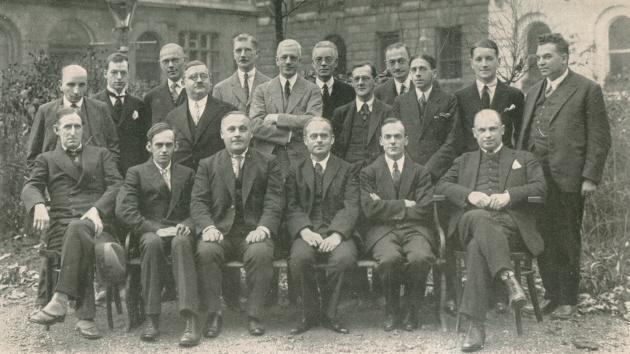
Seated from left to right: F.J.
Marshall, W. Winter, E. Bogoljubow, A. Nimzowitsch, W.A.
Fairhurst, S. Tartakower.
Standing: W.H. Watts, M.E. Goldstein, H. Kmoch, M. Vidmar, R.C.
Griffith, Sir George Thomas, E. Busvine, F.D. Yates, J. Schumer,
E. Colle, V. Buerger, R. Réti
(3959)
It is surprising that Julius du Mont, who knew the Cuban quite well, made so many factual errors in his memoir in Capablanca’s Hundred Best Games of Chess by H. Golombek (London, 1947). A list compiled by us was made available in C.N. 3767, and here we revert to a puzzling case concerning Capablanca and Vidmar. As is well known, on page 17 du Mont wrote about Capablanca:
‘I remember his winning a brilliant game from Dr Vidmar in London, 1922, and laughingly patting the loser on the back, saying: “He always give [sic] me a chance of a brilliancy: he is my meat” – this accompanied by such a charming and good-natured smile that everyone, including Dr Vidmar, had the impression that he had bestowed the finest compliment on his opponent. Who else could make such a remark to his adversary and convey the feeling of the utmost friendliness?’
We quoted this on pages 317-318 of our book on Capablanca and commented:
‘The story cannot be correct, as before London, 1922 Capablanca and Vidmar had met only once, drawing in 20 moves.’
(4566)
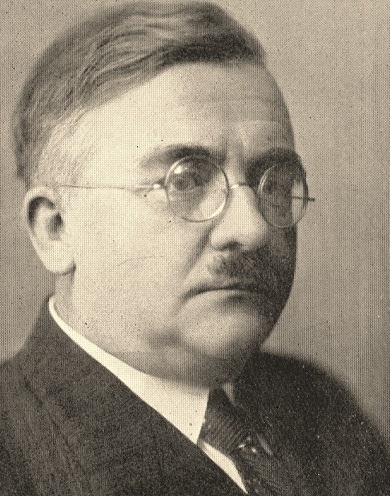
Per Skjoldager (Fredericia, Denmark) draws attention to the conclusion of the game Sämisch v Vidmar, Carlsbad, 1929. Below is the position after Black’s 42nd move, followed by the account by Alfred Brinckmann on page 60 of the tournament book:
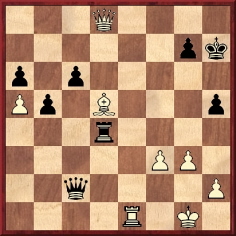
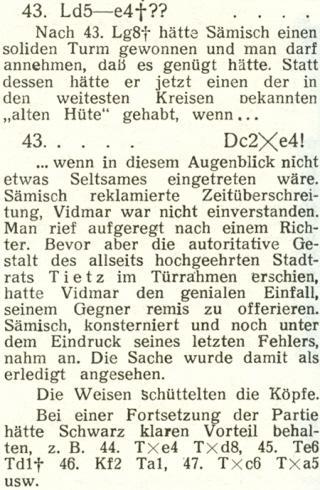
In short, Sämisch could have won a clear rook with 43 Bg8+. After 43...Qxe4 he claimed that Vidmar had overstepped the time-limit, but the latter disagreed. Before the controller arrived, Vidmar offered a draw, which Sämisch accepted. Brinckmann noted that after 44 Rxe4 Rxd8 45 Re6 Rd1+ 46 Kf2 Ra1 47 Rxc6 Rxa5 Black would have had a clear advantage.
Mr Skjoldager has found a slightly different account of the game’s conclusion on page 5 of Bohemia, 2 August 1929:
‘Das Damengambit Sämisch-Dr. Vidmar ergab einen sonderbaren Zwischenfall. Durch eine schöne aber nicht vollkommen korrekte Kombination gewann Sämisch eine Figur. Als er auch noch einen Turm gewinnen könnte, machte Sämisch einen grossen Fehler und stand glatt auf Verlust. Da warf er einem Blick auf die Kontrolluhr und sah, dass Dr. Vidmar die Zeit um zwei Minuten überschritten hatte. Sämisch reklamierte wegen Zeitüberschreitung. Bevor aber der Spielleiter Tietz eine Entscheidung treffen konnte, hatte Dr. Vidmar seinen Gegner Remis angeboten, das Sämisch annahm, so dass der Turnierleiter bereits keine weitere Entscheidung treffen konnte. Die Partie dürfte jedoch noch vor das Schiedsgericht kommen, weil sich die übrigen Spielteilnehmer mit dem Remis nicht einverstanden erklären wollen.’
Our translation:
‘The Queen’s Gambit between Sämisch and Dr Vidmar resulted in an unusual incident. By means of an attractive, though not entirely correct, combination Sämisch won a piece. When he was in a position to win a rook as well, he made a glaring error and found himself on the verge of losing. He then glanced at the clock and saw that Dr Vidmar had exceeded his time by two minutes. Sämisch claimed the game on time. However, before the controller, Tietz, could make a decision, Dr Vidmar offered his opponent a draw, which Sämisch accepted, so that no further decision by the controller could be taken. Nonetheless, the game will probably go before the appeals committee because the other players did not wish to give their agreement to the draw.’
(5060)
A group photograph from page 173 of Deutsche Schachblätter, 1 June 1936:
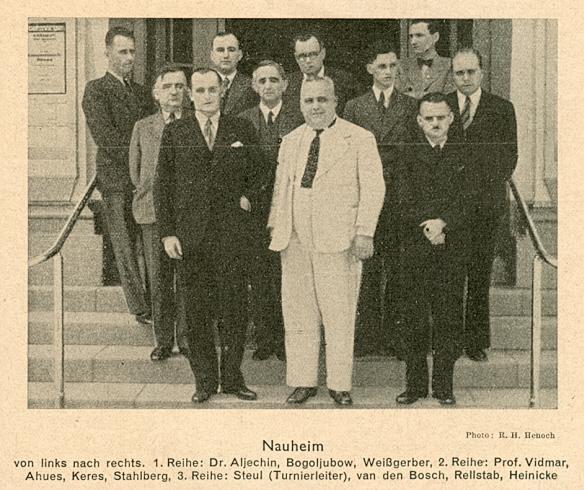
(5244)
Knud Lysdal (Grindsted, Denmark) sends us a number of photographs from his collection, including the following shot of Alekhine v Vidmar, Prague Olympiad, 1931:
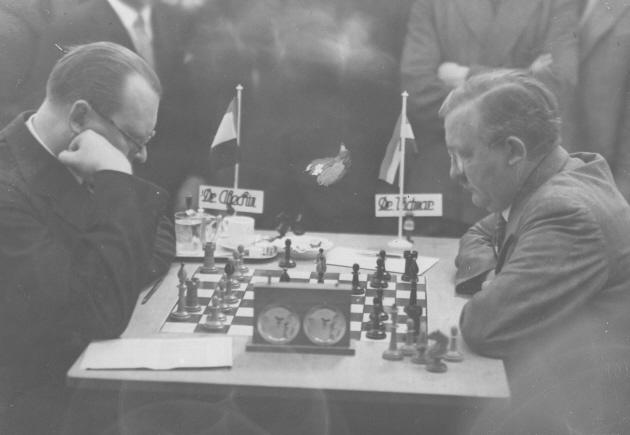
(6529)
Jan Kalendovský (Brno, Czech Republic) owns a postcard of Milan Vidmar Sr:
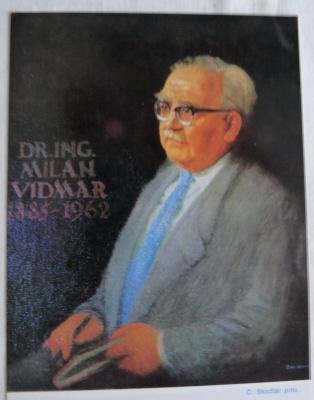
The reverse side was signed by participants in one of the Vidmar Memorial tournaments, but the inscriptions are now faint.
(6961)
From page 60 of the March 1927 American Chess Bulletin:
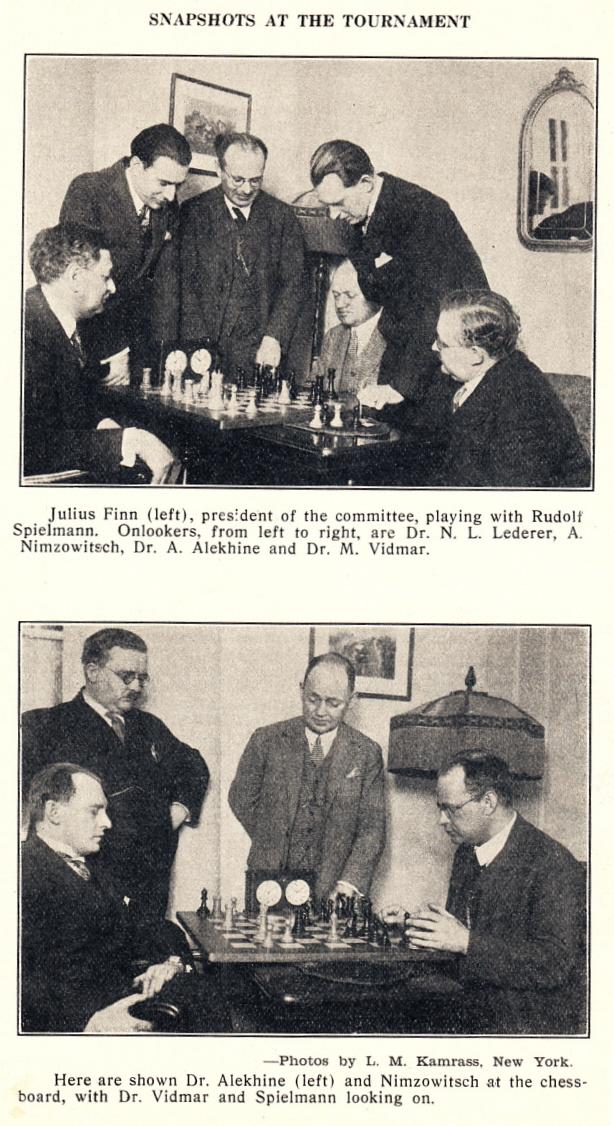
Olimpiu G. Urcan (Singapore), who gave the first photograph on page 226 of his book Julius Finn (Jefferson, 2010), informs us that he has now acquired a much better copy:
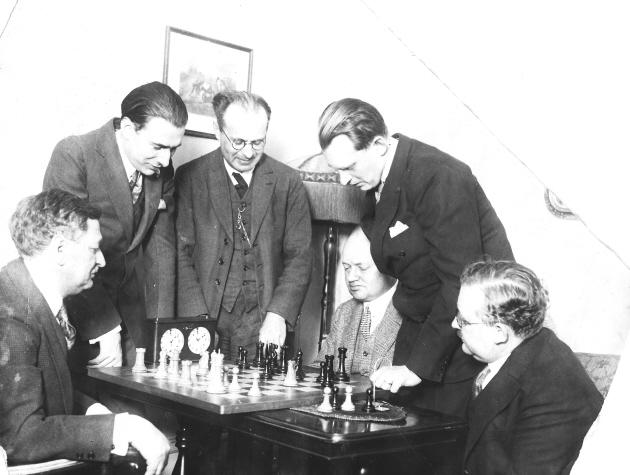
Our correspondent identifies the position as arising in analysis of the third-round game at New York, 1927 between Vidmar and Spielmann:
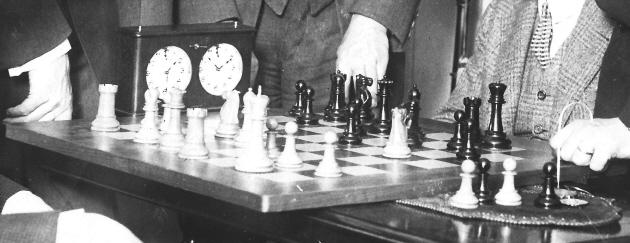
(7602)
From opposite page 144 of Pol stoletja ob šahovnici by Milan Vidmar (Ljubljana, 1951):
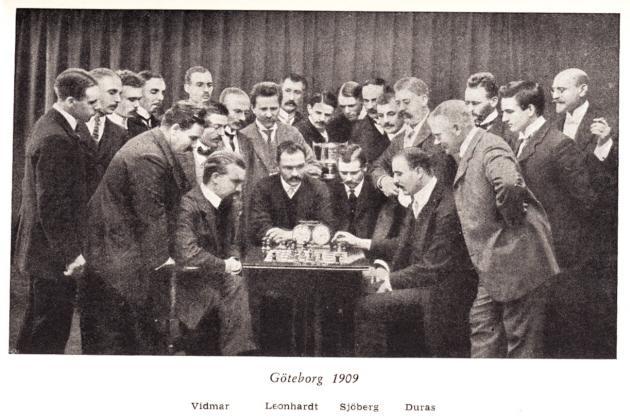
(7617)
Thomas Höpfl (Halle, Germany) points out footage of an anti-Communist rally (Ljubljana, 29 June 1944) in which Milan Vidmar can be seen (beginning at about 2’20”).
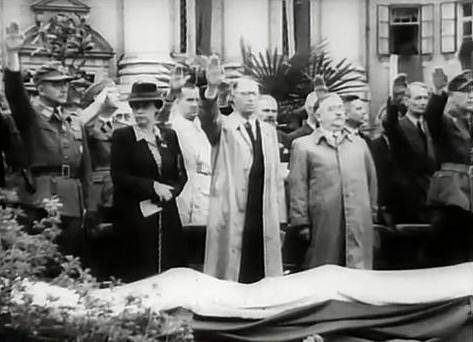
The first part of the coverage also shows Vidmar (at about 4’45” into the item).
(7864)
Mike Forster (Horsham, England) reverts to the topic of penalty moves (C.N.s 5381, 5384 and 5435), mentioning the well-known story about an endgame in which Rubinstein allegedly sealed an intentionally incorrect move, Kc2-c7.
The topic was discussed in C.N.s 903 and 956 (see pages 189-190 of Chess Explorations), and here we add pages 242-243 of Goldene Schachzeiten by Milan Vidmar (Berlin, 1961). It will be noted that, despite the length of the passage, Vidmar could not give particulars.
On page 502 of the September 1976 Chess Life & Review Tim Krabbé referred to Vidmar’s account, and his next paragraph turned to Breyer v Esser, Budapest, 1917, with a suggestion that White craftily touched his unmovable queen’s rook so as to be ‘forced’ to play a brilliant king move (14 Kf1). However, that was all related by Krabbé merely on a ‘the story has it that ...’ basis.
A question arises from page 14 of Chernev’s The Bright Side of Chess:
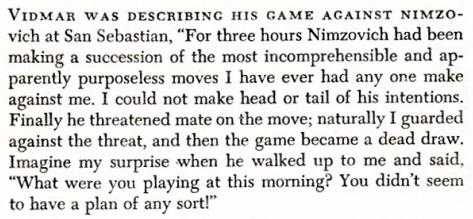
Where did Vidmar write those words, and was the reference really to his game against Nimzowitsch at San Sebastián, 1911 (as opposed to, perhaps, Carlsbad, 1911)?
(8580)
Tartakower is often attributed the remark that it is better to sacrifice the opponent’s pieces, but on what basis?
On page 1 of the New York Times, 16 February 1927 Capablanca wrote about Vidmar:
‘In London, in 1922 (where from the beginning he was a contender for chief honors), while talking about one of the weaker participants, he made the following typical remark:
“He has not learned yet to sacrifice his opponents’ pieces instead of his own.”
He meant, of course, that while a good many players will always look for a chance to sacrifice something in order to obtain a so-called brilliant victory, the real player knows that a sacrifice is only a means to an end, a weapon only to be used when no safer course is available.’
The full article is on pages 154-156 of our monograph on Capablanca. As shown on page 249, the Cuban made similar points in a lecture in Cuba on 25 May 1932:
‘As regards play in general, you will often meet players, especially inexperienced ones, who readily give up pawns, and sometimes even pieces, for an attack. I do not criticize this, because I believe that players must hold the initiative and attack as much as possible. But they should do this as a means of developing their imagination, not in the belief that this is a better way of playing. In this connection I will relate an anecdote about Dr Vidmar, one of the best players in the world who is also a man of science and a man of great ingenuity. At the London Tournament in 1922, in which we both participated, there was a relatively young player who did not have much experience. On a certain occasion, in a game in which he was carrying out a violent attack he sacrificed a piece (or two or three pawns; I do not remember exactly), but it could be seen that this gentleman, despite the attack, would reach an endgame a piece (or pawns) down. With regard to this case, Vidmar remarked that “he had not yet learned that it was the opponent’s pieces that had to be sacrificed”. I mention this anecdote because in reality one should never sacrifice anything when one is playing to win. Although, I repeat, it is a good exercise for young players with little experience. But those who are already knowledgeable and aspire to the first rank should do what Vidmar said: try to sacrifice the opponent’s pieces, since otherwise the attack almost always makes no progress. I wish to insist on this point because sacrificing a piece for an uncertain attack can give a bad result; a piece is too valuable to give it up on the basis of pure speculation. To sacrifice a piece one should be absolutely sure that one will quickly gain compensation, and it is recommended to do so, as I said before and repeat now, in order to exercise the imagination when one is a beginner. The experience of a defeat can help him to prevent an attack against him from being successful and to prevent an opponent’s sacrifice when his combination would be correct. On the other hand, when the sacrifice is not good, you can see that the best players in the world have played for years and years without making such offers, although they are often faced with an attack; they have ended up by winning because they gave up nothing except when they saw that the sacrifice was completely sound.’
(9602)
Below is one of many photographs provided by Gerard Killoran (Ilkley, England) in C.N. 10362, showing Capablanca in play against Vidmar (not Rubinstein):
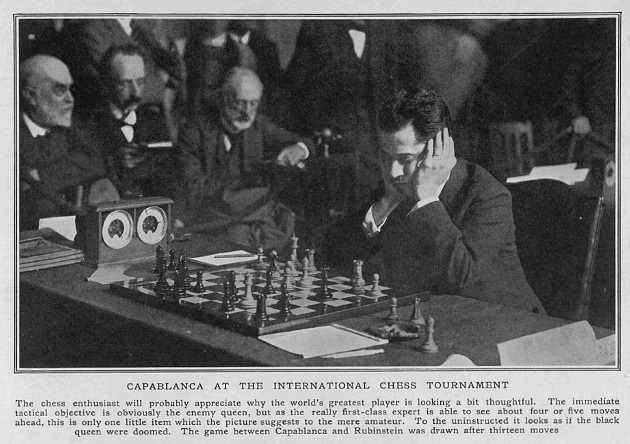
The Tatler, 23 August 1922, page 285
See London, 1922.
Further to Graves of Chess Masters, Jan Hessel (Rättvik, Sweden) reports that earlier this month he took these photographs in the Žale cemetery in Ljubljana:
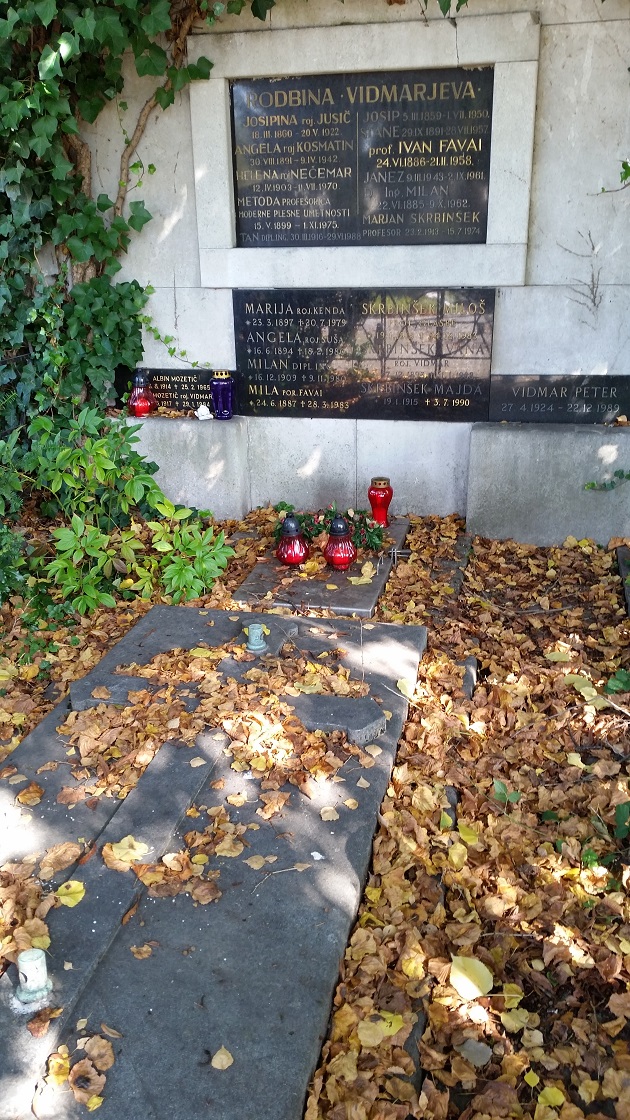
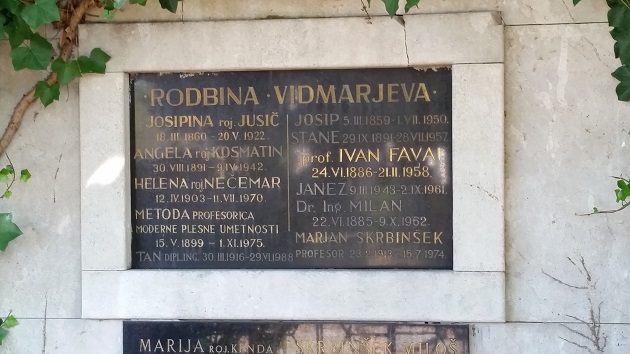
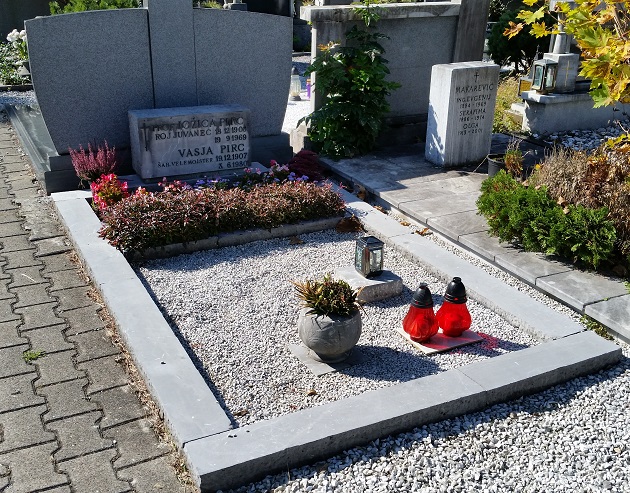
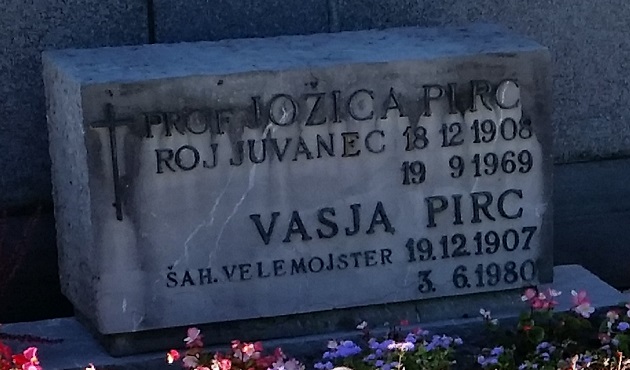
(10627)
An illustration from the short-lived magazine Šah (published in Maribor), January-February 1923, page 49:
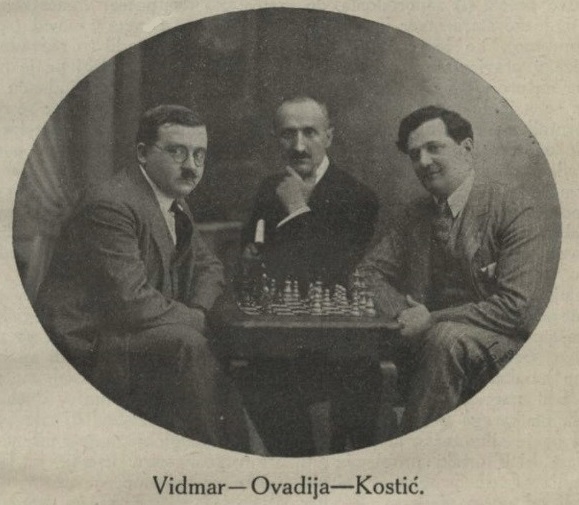
(10899)
‘Vidmar is just a divinely-gifted wood-shifter.’
That comment was by C.J.S. Purdy in the Australasian Chess Review, 12 November 1936, page 290, in an article on that year’s Nottingham tournament:
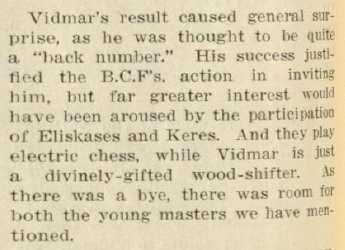
(11620)
Addition on 3 January 2024:
Wijnand Engelkes (Zeist, the Netherlands) draws attention to a documentary film about Vidmar.
To the Archives
for other feature articles.
Copyright Edward Winter. All rights reserved.